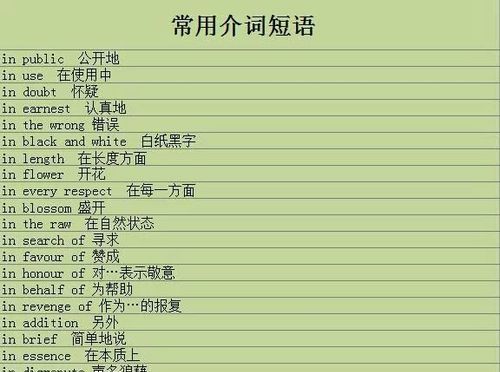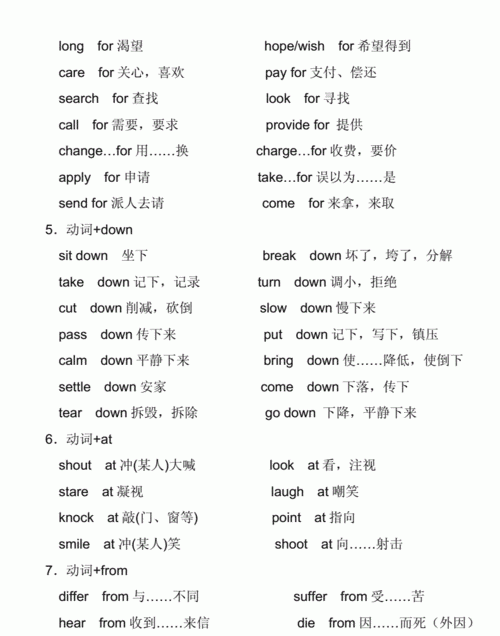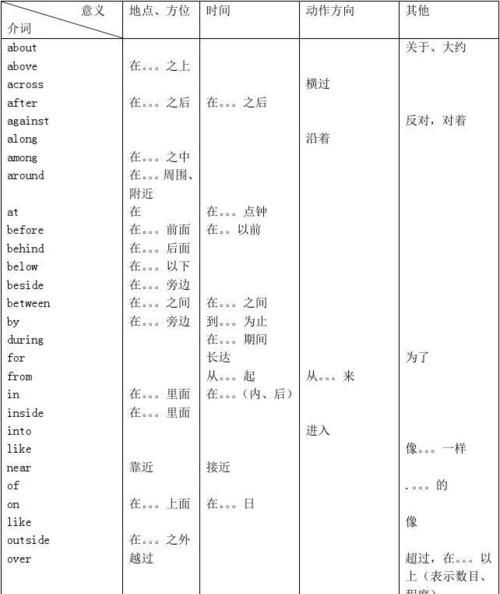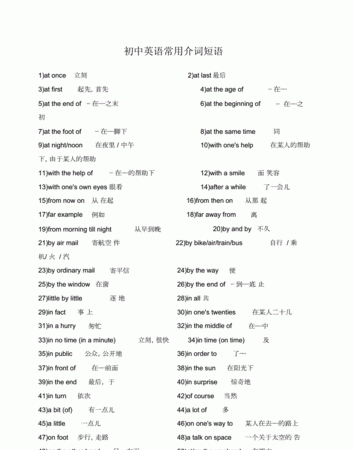本文目录
初中的英语中常用的介词有哪些?
英语中最常用的介词,按照不同的分类标准可分为以下几类:
(1). 简单介词、复合介词和短语介词
①.简单介词是指单一介词。如:
at , in ,of ,by , about , for, from , except , since, near, with 等。
②. 复合介词是指由两个简单介词组成的介词。如:
Inside, outside , onto, into , throughout, without , as to as for , unpon, except for 等。
③. 短语介词是指由短语构成的介词。如:
In front of , by means o f, on behalf of, in spite of , by way of , in favor of , in regard to 等。
(2). 按词义分类
{1} 表地点(包括动向)的介词。如:
About ,above, across, after, along , among, around , at, before, behind, below, beneath, beside, between , beyond ,by, down, from, in, into , near, off, on, over, through, throught, to, towards,, under, up, unpon, with, within , without 等。
{2} 表时间的介词。如:
About, after, around , as , at, before , behind , between , by, during, for, from, in, into, of, on, over, past, since, through, throughout, till(until) , to, towards , within 等。
{3} 表除去的介词。如:
beside , but, except等。
{4} 表比较的介词。如:
As, like, above, over等。
{5} 表反对的介词。如:
againt ,with 等。
{6} 表原因、目的的介词。如:
for, with, from 等。
{7} 表结果的介词。如:
to, with , without 等。
{8} 表手段、方式的介词。如:
by, in ,with 等。
{9} 表所属的介词。如:
of , with 等。
{10} 表条件的介词。如:
on, without , considering 等。
{11} 表让步的介词。如:
despite, in spite notwithstanding等。
{12} 表关于的介词。如:
About, concerning, regarding ,with regard to, as for , as to
{13} 表对于的介词。如:
to, for over , at , with 等。
{14} 表根据的介词。如:
on, according to 等。
{15} 表其他的介词。如:
for(赞成),without(没有)等。

初中英语方位介词有哪些
⑴ 时间或地点介词in、on、at的用法区别:表示时间时, in表示在一段时间里(在将来时句子中则表示在一段时间之后), on表示在具体的某一天或者某天的上下午等, at表示在某个时刻或者瞬间;表示地点时, in表示在某个范围之内, on表示在某个平面上或与一个面相接触,at则表示在某个具体的场所或地点。如:He was born on the morning of May 10th.(他出生于五月十日的早晨)/ I usually get up at 7:00 in the morning.(我通常在早上的七点钟起床) / His glasses are right on his nose.(他的眼镜就架在他的鼻子上)/ He is at the cinema at the moment.(此刻他正在电影院)
⑵ after与in表示时间的用法区别:“after+(具体时刻/从句)”表示“在…时刻之后”常用于一般时态;“in+(一段时间)”表示“在(多久) 之后”,常用于将来时态。如:He said that he would be here after 6:00.(他说他六点钟之后会来这儿)/ My father is coming back from England in about a month.(我父亲大约一个月以后从英国回来)
⑶ since与for表示时间的用法区别:“since+(具体时刻/that-从句)”表示“自从…起一直到现在”,“for +(一段斶间)”表示“总共有…之久”,都常用于完成时态;如:Uncle Li has worked in this factory since 1970.(李叔叔自从1970年起就在这家工厂工作了)/ Uncle Li has worked in this factory for over 30 years. (李叔叔在这家工厂已经工作了30多年)
⑷ by、in与with表示方式的用法区别:都可以表示“工具、手段”,但是by主要表示“乘坐”某个交通工具或“以……方式”,在被动句中可以表示动作的执行者;in表示“使用”某种语言/文字,with表示“使用”某个具体的工具、手段。如:We see with our eyes and walk with our feet.(我们用眼睛看东西,用双脚走路)/ Please write that article(文章) in English.(请你用英语写那篇文章)/ Let’s go to the zoo by taxi.(我们打的去动物园吧。)/ It was written by Lao She.(那是老舍写的)
⑸ about与on的用法区别:都可以表示“有关…”,但是about的意义比较广,而on主要表示“有关…(专题/课程)”。如:Tom is going to give a talk on the history of America.(汤姆要作一个美国历史的报告)/ They are very excited talking about the coming field trip.(他们兴致勃勃地谈论着即将来到的野外旅游)
⑹ through与across、over的用法区别: through指“穿过…(门洞/人群/树林)”; across和over可以指“跨越…(街道/河流)”,可互换,但是表示“翻过…”时只能用over. 如:Just then a rat (鼠)ran across the road.(就在那时一只老鼠跑过路面)/ There is a bridge across/over the river.(河上有座桥)/ They climbed over the mountain and arrived there ahead of time.(他们翻过大山提前到达了那里)/ The visitors went through a big gate into another park.(参观者们穿过一个大门来到另一个公园)
(7)as与like的区别:两个词都表示“像……”,但是as译为“作为……”,表示的是职业、职务、作用等事实,而like译为“像……一样 ”,表示外表,不是事实。如:Let me speak to you as a father.(我以父亲的身份和你讲话。)(说话者是听者的父亲) / Let me speak to you like a father.(让我像一位父亲一样和你讲话)(说话者不是听者的父亲)
(8)at the end of、by the end of、to the end、in the end的用法区别:at the end of…既可以表示时间也可以表示地点,译为“在…末;在…尽头”,常与过去时连用;by the end of…只能表示时间,译为“在…前;到…为止”,常用于过去完成时; in the end与at last基本等义,表示“终于、最后”,通常用于过去时;to the end译为“到…的终点为止”,前面往往有表示运动或连续性的动词。如:By the end of last term we had learned 16 units of Book III.(到上学期期末我们已经学习了第三册16个单元)/ At the end of the road you can find a big white house with brown windows.(在路的尽头你能找到一幢有棕色窗户的白房子)/ They left for Beijing at the end of last week.(上周末他们动身去了北京)/ In the end he succeeded in the final exams.(他最终在期末考试中考及格了)/ We should go on with the work to the end.(我们应该把工作干到底)/ Follow this road to the end and you will see a post office.(沿这条路走到底就能看见一家邮电局)
(9)for a moment、for the moment、in a moment、at the moment的区别:for a moment“一会儿、片刻”(=for a while),常与持续性动词连用;for the moment“暂时、目前”,常用于现在时;in a moment“一会儿、立即、马上”(=soon; in a few minutes),一般用于将来时;at the moment“此刻,眼下”(=now),用于现在进行时。如:Please wait for a moment.(请稍等)/ Let’s leave things as they are for the moment.(暂时就维持现状吧!) / I’ll come back in a moment.(我过会儿回来)/ I am very busy at the moment.(眼下我很忙)
(10)but的问题:用介词but引出另一个动词时,要注意:如果前面有do,后面就用原形动词,前面没有do时,后面的动词要加to。如:I could do nothing but wait.(我什么也做不了只能等) / They had no choice(选择) but to fight.(他们没有选择只有战斗)
(11)in front of 与in the front of: in front of“在…的前面”, 与in the front of“在…的前部”。如:A car was parking in front of the hall.(大厅跟前停着一辆汽车)/ In the front of the hall stood a big desk.(大厅前部立着一个大讲台)
(12)except (for)与besides的区别:except“除了”,表示排除掉某人物,即不包含;而besides“除了”则表示包含,即“不仅……又……”。如:Everyone went to the Palace Museum except Tom.(除了Tom,大家都去了故宫博物院)(Tom没有去故宫)/ Besides Chinese he also studied many other subjects.(除了汉语之外,他还学其他许多功课)(“汉语”也是他学的功课之一)
other than 除了......之外...... There 're nobody here other than me 与.....不同..... 与.....不同方式.....we can't get there other than by swimming.
Apart from : with the exception of ...; besides... Apart form a few scratches, the car was undamaged.

初中英语常用介词50个
1)简单介词:about, across, after, against, among, around, at, before, behind, below, beside, but, by, down, during, for, from, in, of, on, over, near, round, since, to, under, up, with等等。
2)合成介词:inside, into, outside, throughout, upon, without, within
3)短语介词:according to, along with, apart from, because of, in front of, in spite of, instead of, owing to, up to, with reguard to
4)分词介词:considering, reguarding, including, concerning
2.从意思上考虑,介词可分为下面三类:
1)引导时间短语的介词:
at, on, in, during, before, after, over, from, following, by, till, until, towards, for, throughout, upon, since, pending, all through, prior to
2) 引导地点状语的介词:
in, at, across, to, down, under, near, between, over, from, into, through, onto, off, outside, out of, inside, within, beside, behind, below, among, beyond, against, around, before, up, ahead of, via, in front of, under, along, past, opposite, above, next to
3) 引导其他短语的介词:
by, with, about, except, like, of, according to, instead of, without, in, due to, because of, along with, as for, in spite of, on account of owing to, on behalf of, against, apart from, for, failing, plus, including, in regard to, with regard to
偶尔有一些不常用。。。

初中的英语中常用的介词有哪些?
一、介词按其构成可分为: 1. 简单介词 at, in, on, to, since, until等。如: He's worked there since 1998. 2. 复合介词 into, onto, out of等。如: She is out of school. 她毕业了。 3. 二重介词 from under, from behind, from out of, until after, except in等。如: I'm from out of town. 我是从城外来的。 4. 短语介词 because of, instead of, in spite of等。如: I went back not because of the rain, but because I was tired.我回去不是因为下雨,而是因为我累了。 二、介词的作用: 1. 表示地点: after, along, at, below, by, of, near, over, through, under等。如: Near the village the boys are skating on the ice. 男孩子们正在村子附近的冰上滑冰。 They lay down under the shade of a tree. 他们躺在一棵树的树阴下。 2. 表示时间: about, after, across, at, during, for, in, of, till, until等。如: After class he will tell us about the accident. 课后他将告诉我们有关事故的情况。 A heavy rain has been falling across three days. 一场大雨下了整整三天。 The accident happened during the night. 事故发生在夜间。 3. 表示动作: at, across, around, on, over, under等。如: The earth goes around the sun. 地球绕太阳运行。 The car is under repair. 汽车在修理中。 4. 表示比较: as, like, above, over, with等。如: She was something like her sister. 她有几份像她的妹妹。 Chinese is much more difficult in contrast with English. 和英语相比,汉语难得多。 5. 表示原因: about, for, from, with等。如: Don't worry about my lessons. 不要担心我的功课。 Business kept me from coming. 我因事不能来。 He was angry with what I did. 他对我所做的很气愤。 6. 表示条件: to, with, without等。如: Without your advice, he would have failed. 没有你的忠告他可能已经失败了。 7. 表示手段、方式: as, by, in, with等。如: He behaved as a drunkard. 他的举止如同醉汉一样。 Learn the new words by heart.记住这些生词。 We see with our eyes.我们用眼睛看。 8. 表示距离、数量: from, in, within等。如: My house is ten miles from the school. 我家离学校十英里。 They were thirty in all. 他们总共有三十人。 9. 表示目的: as, for等。如: I only said it as a joke. 我只是把它当作笑话讲的。 It's time for class. 到上课的时间了。 10. 表示让步: for, with等。如: For all his effort, he didn't succeed. 虽然他做了一番努力,仍不能成功。 With all his money, he is unhappy. 尽管他有钱,但他并不快乐。 for还可以引导插入语,例如: I, for one, shall vote against the proposal. 我也投票反对这个提议以上希望对你有帮助,是几乎所有介词的用法了 by的用法(1)表示在……旁,如by the fire 在炉火旁。(2)用于被动语态,表示“被”,如It is planted by Tom . (3)到……为止,在……以前,如We can get the books by Monday . (4)依照,依据,如By your theory , ……,按你的理论,……(5)表示方法,手段,by sea乘船,by bus(6)由于,因……,I”d know you by your laugh . (7)表示把,握的部位,She pulled me by the sleeve . 她抓住我的衣袖。in的用法:in是介词,介词后面必须接名词,代词或者动名词,即doing。 这是介词的一个特点,当介词in单独使用时,或者与其它动词构成固定搭配时,都不能脱离其作为介词的特点。in 常用意思:在..., 在...之内,从事于..., 按照..., 穿着...。 He was born in 1992. 他生于1992年。 I could finish the program in two weeks.我可以用两周时间完成这个项目。 He spend less time in reading.他读书时间很少。 The man in black jacket is our teacher.穿黑夹克的那个人是我们的老师。in是介词,介词后面必须接名词,代词或者动名词,即doing。 这是介词的一个特点,当介词in单独使用时,或者与其它动词构成固定搭配时,都不能脱离其作为介词的特点。in 常用意思:在..., 在...之内,从事于..., 按照..., 穿着...。 He was born in 1992. 他生于1992年。 I could finish the program in two weeks.我可以用两周时间完成这个项目。 He spend less time in reading.他读书时间很少。 The man in black jacket is our teacher.穿黑夹克的那个人是我们的老师。 一些与介词in的固定搭配 表示时间in 1999, in 20 century,表示地点in a car, in a queue, 表示状态in charge(看管), in church, in class,to的用法一:表示相对,针对 be strange (common, new, familiar) to二:表示对比,比较1:以-ior结尾的形容词,后接介词to表示比较,如:superior ,inferior,prior,senior,junior The quarrel happened prior to my arrival. 2:一些本身就含有比较或比拟意思的形容词,如equal,similar,equivalent,analogous A is similar to B in many ways. 3:表示一些先后顺序的形容词,如:second,subsequent,next,preliminary,preparatory 4:to也偶尔出现在个别动词之后,与动词形成固定词组,表示比较,如:prefer to,compare to,in contrast to compare to sth.表示比喻或比拟,而compare with sth.表示比较,如: World is usually compared to a stage

以上就是关于初中所有介词短语 ,初中的英语中常用的介词有哪些?的全部内容,以及初中所有介词短语 的相关内容,希望能够帮到您。
